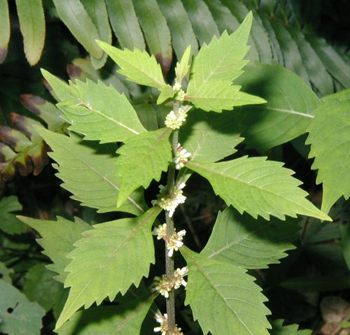Contents:
Common Names | Parts Usually Used | Plant(s) & Culture | Where Found | Medicinal Properties | Biochemical Information
Legends, Myths and Stories | Uses | Formulas or Dosages | Warning | Bibliography
Scientific Names

- Lycopus virginicus L.
- Labiatae
- Mint family
Common Names
- Gypsywort
- Sweet bugle
- Water bugle
- Western bugleweed
Parts Usually Used
The whole plant (usually the aerial parts)
Back to Top
Description of Plant(s) and Culture
Bugleweed is a perennial plant 6-40 inches in height; the leaves are lance-shaped, strongly toothed, the lower ones with long, narrow bases. Flowers are in axils, with broadly triangular calyx lobes, shorter than the nutlets. Blooms July to October.
Another variety: American bugleweed (L. americanus) also called cut-leaved water-horehound; the most abundant of about 7 or so species in our range; distinguished by its lance-shaped, strongly cut or toothed leaves. Found on low ground throughout North America. Flowers in July to September. The leaves of this and other bugleweeds (Lycopus species) are traditionally used as a mild sedative and astringent in heart diseases, lung ailments, etc.
Another variety: also called gypsywort or bugleweed (L. europaeus) is a little known but efficacious medicinal plant. In Switzerland it is found in some parts of the Churfirst mountains at an elevation of up to 3,280 feet. Used in similar ways to bugleweed (L. virginicus).
Back to Top
Where Found
Wet places, Nova Scotia to Georgia; Arkansas to Oklahoma, Nebraska to Minnesota.
Back to Top
Medicinal Properties
Sedative, astringent, mild narcotic, tonic
Back to Top
Biochemical Information
Tannin, lithospermic acid, phenolic substances and traces of essential oil
Back to Top
Legends, Myths and Stories
The Chinese variety (L lucidus) closely resembles bugleweed (L. virginicus), but the Chinese plant has emmenagogue and diuretic properties and is used for delayed menstruation and urinary problems.
Rafinesque thought exceedingly well of bugleweed’s general properties, further he claims that it acts somewhat like digitalis, lowering pulse, without producing any bad effects, nor accumulating in the system.
The Herbalist Almanac states that most writers believe the plant is narcotic, but “we, however, infer, both from our own experience, and that of others, that it is only a sedative”.
Back to Top
Uses
Used especially for heart diseases, chronic lung ailments, coughs, fast pulse, thyroid diseases, diabetes. Science has confirmed the potential value of this plant in treating hyperthyroidism, especially when combined with motherwort. Effects are only noted after taking the combination for 2 weeks.
Back to Top
Formulas or Dosages
Should be used in its fresh state, or freshly tinctured, not dried.
Infusion: use 1 oz. of the herb, cut fine, to 1 pint of boiling water. Let cool and take a cupful several times a day
Back to Top
Warning
Generally bugleweed should be avoided during pregnancy, as are most herbs in this category.
Back to Top
Bibliography
![]() American Folk Medicine
American Folk Medicine, by Clarence Meyer, Meyerbooks, publisher, PO Box 427, Glenwood, Illinois 60425, 1973
![]() Back to Eden
Back to Eden, by Jethro Kloss; Back to Eden Publishing Co., Loma Linda, CA 92354, Original copyright 1939, revised edition 1994
![]() Eastern/Central Medicinal Plants
Eastern/Central Medicinal Plants, by Steven Foster and James A. Duke., Houghton Mifflin Company, 215 Park Avenue South, New York, NY 10000
![]() The Herbalist Almanac
The Herbalist Almanac, by Clarence Meyer, Meyerbooks, publisher, PO Box 427, Glenwood, Illinois 60425, copyright 1988, fifth printing, 1994
 How Indians Use Wild Plants for Food, Medicine & Crafts
How Indians Use Wild Plants for Food, Medicine & Crafts, by Frances Densmore, Dover Publications, Inc., 180 Varick Street, New York, NY 10014, first printed by the United States Government Printing Office, Washington, in 1928, this Dover edition 1974
![]() The Nature Doctor: A Manual of Traditional and Complementary Medicine
The Nature Doctor: A Manual of Traditional and Complementary Medicine, by Dr. H.C.A. Vogel; Keats Publishing, Inc., 27 Pine Street (Box 876) New Canaan, CT. 06840-0876. Copyright Verlag A. Vogel, Teufen (AR) Switzerland 1952, 1991
![]() Planetary Herbology
Planetary Herbology, by Michael Tierra, C.A., N.D., O.M.D., Lotus Press, PO Box 325, Twin Lakes. WI 53181., Copyright 1988, published 1992
![]() Webster’s New World Dictionary
Webster’s New World Dictionary, Third College Edition, Victoria Neufeldt, Editor in Chief, New World Dictionaries: A Division of Simon & Schuster, Inc., 15 Columbus Circle, New York, NY 10023
 The Rodale Herb Book: How to Use, Grow, and Buy Nature’s Miracle Plants (An Organic gardening and farming book)
The Rodale Herb Book: How to Use, Grow, and Buy Nature’s Miracle Plants (An Organic gardening and farming book), edited by William H. Hylton, Rodale Press, Inc. Emmaus, PA, 18049., 1974
